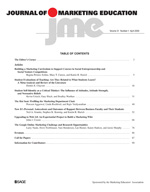Multicultural Sensitivity for Marketing Students
 Editor’s note: We are pleased to welcome Dr. Mark S. Rosenbaum, Kohl’s Professor of Retail Marketing at Northern Illinois University. Dr. Rosenbaum provided this commentary on his paper, “A Multicultural Service Sensitivity Exercise for Marketing Students,” co-authored by Ioana Moraru of Northern Illinois University and Dr. Lauren I. Labrecque of Loyola University Chicago and published on October 4, 2012 in the Journal of Marketing Education.
Editor’s note: We are pleased to welcome Dr. Mark S. Rosenbaum, Kohl’s Professor of Retail Marketing at Northern Illinois University. Dr. Rosenbaum provided this commentary on his paper, “A Multicultural Service Sensitivity Exercise for Marketing Students,” co-authored by Ioana Moraru of Northern Illinois University and Dr. Lauren I. Labrecque of Loyola University Chicago and published on October 4, 2012 in the Journal of Marketing Education.
 Marketing educators place service quality at the heart of the curriculum, painting service providers as defenders of their customers’ welfare and thwarters of service failures. In reality, this rosy imagery is not always true. Oftentimes o
Marketing educators place service quality at the heart of the curriculum, painting service providers as defenders of their customers’ welfare and thwarters of service failures. In reality, this rosy imagery is not always true. Oftentimes o ther customers negatively impact the service encounter and service providers themselves can also act as discriminatory agents toward their own customers. In “A Multicultural Service Sensitivity Exercise for Marketing Students,” which appears in a forthcoming edition of the Journal of Marketing Education, we discuss the importance of engaging students with the discussion of service discrimination and describe an in-class exercise to help educators prepare students to face this reality.
ther customers negatively impact the service encounter and service providers themselves can also act as discriminatory agents toward their own customers. In “A Multicultural Service Sensitivity Exercise for Marketing Students,” which appears in a forthcoming edition of the Journal of Marketing Education, we discuss the importance of engaging students with the discussion of service discrimination and describe an in-class exercise to help educators prepare students to face this reality.
What inspired you to be interested in this topic?
The topic was inspired from years of practical experience prior to academia, working in one of Chicago’s largest shoes stores and Saks Fifth Avenue and my own experience of retail discrimination while shopping with my partner. In 2007 I published an article in the Journal of Business Research that really brought to light the fact that other customers often conduct discriminatory acts towards other shoppers, and employees also engage in this behavior unbeknown to the human resources department. I’ve also experienced discrimination firsthand as a Caucasian living in Honolulu. This discrimination was often performed by Japanese front-front employees who used racial profiling to determine what level of services to offer. In fact, many of my Caucasian friends would plan shopping trips in Las Vegas or Waikiki in order to avoid discrimination.
Over the six years that I’ve been teaching services marketing and retail, I’ve realized that these topics are not covered in-depth in any of the textbooks and that students weren’t being exposed to these realities. We tell students that service employees should be customer champions, when in fact this isn’t reality. The most interesting and powerful things about this exercise are that students openly admit to knowing and experiencing discrimination. In essence, this exercise exposes the elephant in the room.
Were there findings that were surprising to you?
The most surprising finding for me was the level of openness of the students and how willing we are to accept these discriminatory practices. For many, the topic is nothing new. They know this exists and think of it as “normal”; however, the key difference here is that although most are aware of it none have really ever talked openly about it and thought about the impact that it has on others. For example, when discussing how groups of young African-American males are followed by employees to watch out for shoplifting, or how obese people are treated with difference service standards, there is nearly a unanimous class acceptance that this is “normal.” It’s as if we tell ourselves this is okay to understand why employees would alter their service quality. Perhaps discrimination is part of our biological narrative. Meaning, maybe it’s inherent in our DNA. It’s the managers’ role to unravel our DNA, break this tendency, and stop the discriminatory actions towards marginalized or stigmatized status.
How do you see this study influencing future research and/or practice?
This exercise is a dosage of practical reality for any classroom and is aligned with the AACSB initiatives for including diversity in the classroom. Students often remark that this is the one thing that really sticks with them from class. I’ll never forgot an MBA student leaving my class in tears after she came to the realization that she was responsible for encouraging her staff to engage in discriminatory behavior.
It’s essential that we come to the realization that service employees are not always the champions of service quality. And unfortunately, in an economic situation that is constraining training budgets, it is even more important for educators to ensure that future managers are exposed to diversity and multicultural issues. My hope is that this topic will be discussed in-depth in future editions of services marketing and retailing textbooks.
***
Click here to read the article in the OnlineFirst section of the Journal of Marketing Education. Follow this link to learn more about the journal and this one to receive e-alerts about new research covering the ideas, information, and experiences related to educating students of marketing and advertising.



























































































